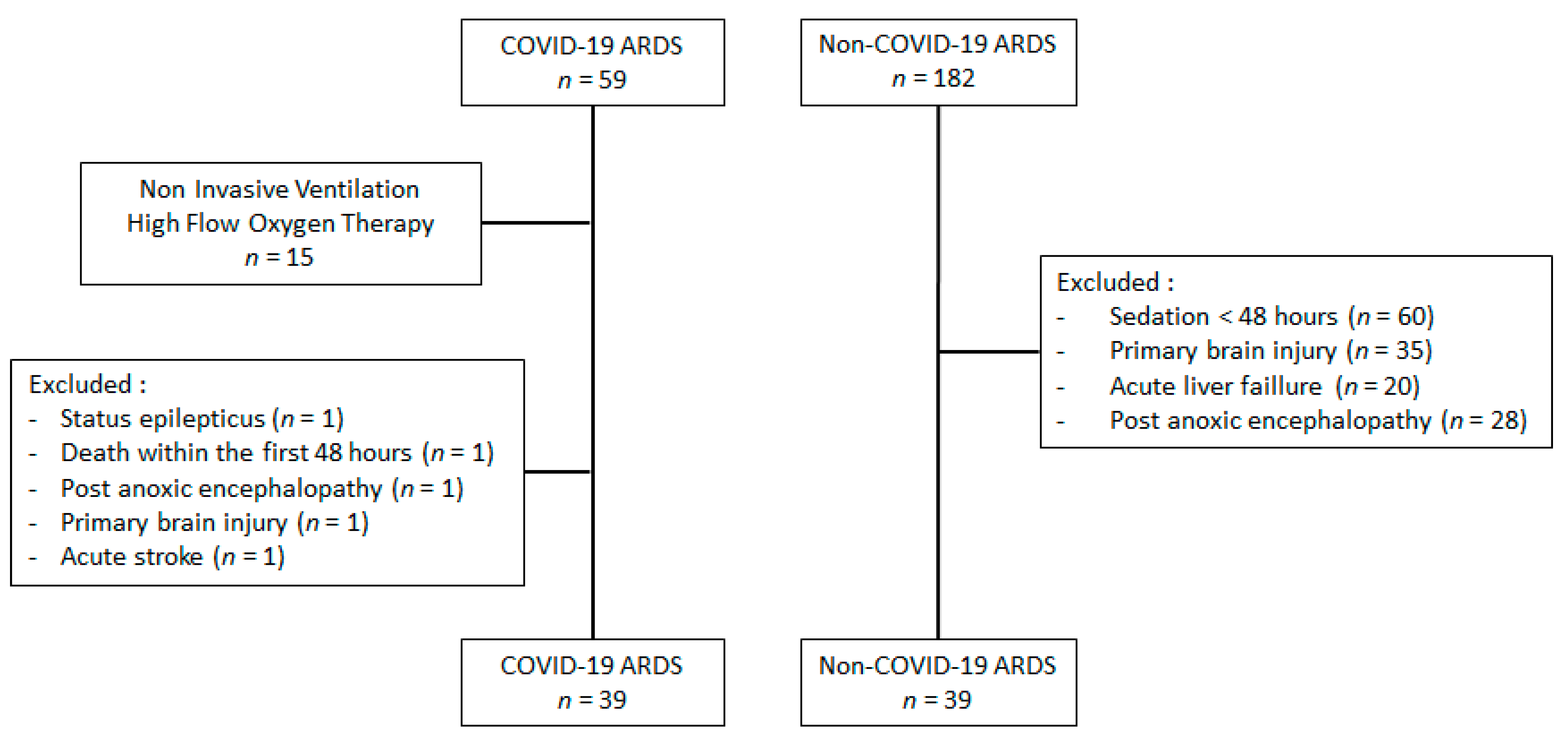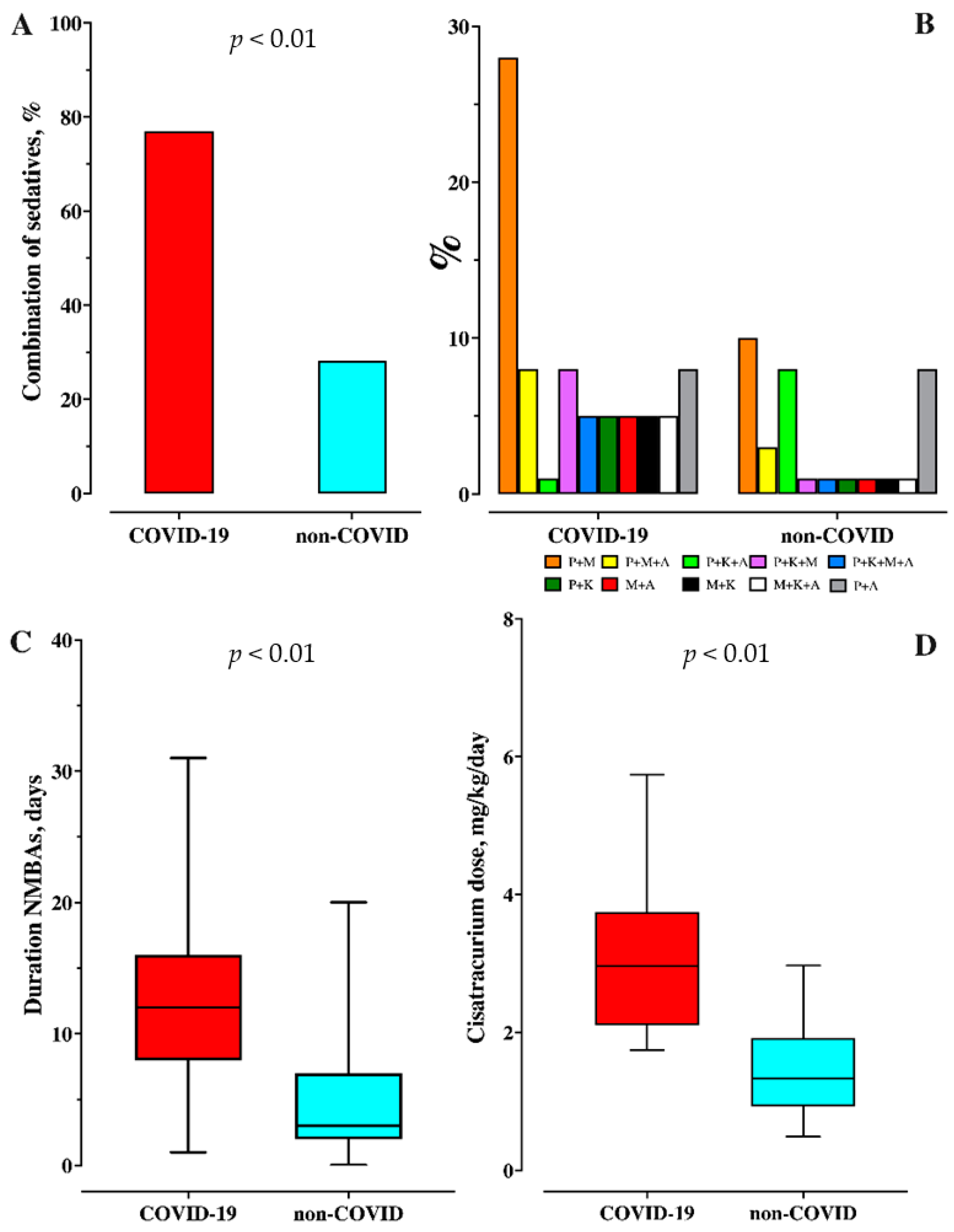Use of Sedatives and Neuromuscular-Blocking Agents in Mechanically Ventilated Patients with COVID-19 ARDS
Abstract
:1. Introduction
2. Materials and Methods
2.1. Study Design
2.2. Study Population
2.3. Data Collection and Sedation Management
2.4. Outcome Assessment
2.5. Statistical Analysis
3. Results
4. Discussion
5. Conclusions
Author Contributions
Funding
Institutional Review Board Statement
Informed Consent Statement
Data Availability Statement
Conflicts of Interest
References
- Kim, L.; Garg, S.; O’Halloran, A.; Whitaker, M.; Pham, H.; Anderson, E.J.; Armistead, I.; Bennett, N.M.; Billing, L.; Como-Sabetti, K.; et al. Risk Factors for Intensive Care Unit Admission and In-hospital Mortality Among Hospitalized Adults Identified through the US Coronavirus Disease 2019 (COVID-19)-Associated Hospitalization Surveillance Network (COVID-NET). Clin. Infect. Dis. 2020, 72, e206–e214. [Google Scholar] [CrossRef] [PubMed]
- Di Castelnuovo, A.; Bonaccio, M.; Costanzo, S.; Gialluisi, A.; Antinori, A.; Berselli, N.; Blandi, L.; Bruno, R.; Cauda, R.; Guaraldi, G.; et al. Cardiovascular risk factors and in-hospital mortality in 3,894 patients with COVID-19: Survival analysis and machine learning-based findings from the multicentre Italian CORIST Study. Nutr. Metab. Cardiovasc. Dis. 2020, 30, 1899–1913. [Google Scholar] [CrossRef] [PubMed]
- Taccone, F.S.; Van Goethem, N.; De Pauw, R.; Wittebole, X.; Blot, K.; Van Oyen, H.; Lernout, T.; Montourcy, M.; Meyfroidt, G.; Van Beckhoven, D. The role of organizational characteristics on the outcome of COVID-19 patients admitted to the ICU in Belgium. Lancet Reg. Health Eur. 2021, 2, 100019. [Google Scholar] [CrossRef]
- Chanques, G.; Constantin, J.-M.; Devlin, J.W.; Ely, E.W.; Fraser, G.L.; Gélinas, C.; Girard, T.D.; Guérin, C.; Jabaudon, M.; Jaber, S.; et al. Analgesia and sedation in patients with ARDS. Intensiv. Care Med. 2020, 46, 2342–2356. [Google Scholar] [CrossRef] [PubMed]
- Flinspach, A.N.; Booke, H.; Zacharowski, K.; Balaban, U.; Herrmann, E.; Adam, E.H. High sedation needs of critically ill COVID-19 ARDS patients-A monocentric observational study. PLoS ONE 2021, 16, e0253778. [Google Scholar] [CrossRef] [PubMed]
- Tapaskar, N.; Hidalgo, D.C.; Koo, G.; Shingada, K.; Rao, S.; Rodriguez, R.; Rech, M.A. Sedation Usage in COVID-19 Acute Respiratory Distress Syndrome: A Multicenter Study. Ann. Pharmacother. 2021. [Google Scholar] [CrossRef] [PubMed]
- Aldhaeefi, M.; Dube, K.M.; Kovacevic, M.P.; Szumita, P.M.; Lupi, K.E.; DeGrado, J.R. Evaluation of Rocuronium Continuous Infusion in Critically Ill Patients During the COVID-19 Pandemic and Drug Shortages. J. Pharm. Pr. 2021. [Google Scholar] [CrossRef] [PubMed]
- Force, A.D.T.; Ranieri, V.M.; Rubenfeld, G.D.; Thompson, B.T.; Ferguson, N.; Caldwell, E.; Slutsky, A.S. Acute respiratory distress syndrome: The Berlin Definition. JAMA 2012, 307, 2526–2533. [Google Scholar]
- Mirski, M.A.; LeDroux, S.N.; Lewin, J.J.; Thompson, C.B.; Mirski, K.T.; Griswold, M. Validity and reliability of an intuitive conscious sedation scoring tool: The nursing instrument for the communication of sedation. Crit. Care Med. 2010, 38, 1674–1684. [Google Scholar] [CrossRef] [PubMed]
- Pereira, J.; Lawlor, P.; Vigano, A.; Dorgan, M.; Bruera, E. Equianalgesic dose ratios for opioids: A critical review and proposals for long-term dosing. J. Pain Symptom Manag. 2001, 22, 672–687. [Google Scholar] [CrossRef]
- Kapp, C.M.; Zaeh, S.; Niedermeyer, S.; Punjabi, N.M.; Siddharthan, T.; Damarla, M. The Use of Analgesia and Sedation in Mechanically Ventilated Patients with COVID-19 ARDS. Anesth. Analg. 2020, 131, e198–e200. [Google Scholar] [CrossRef] [PubMed]
- Balakrishna, A.; Walsh, E.C.; Hamidi, A.; Berg, S.; Austin, D.; Pino, R.M.; Bittner, E.A. An examination of sedation requirements and practices for mechanically ventilated critically ill patients with COVID-19. Am. J. Health Syst. Pharm. 2021, 78, 1952–1961. [Google Scholar] [CrossRef] [PubMed]
- Gattinoni, L.; Marini, J.J.; Camporota, L. The Respiratory Drive: An Overlooked Tile of COVID-19 Pathophysiology. Am. J. Respir. Crit. Care Med. 2020, 202, 1079–1080. [Google Scholar] [CrossRef] [PubMed]
- Page, V. Sedation in mechanically ventilated patients with COVID-19. Lancet Respir. Med. 2021, 9, 218–219. [Google Scholar] [CrossRef]
- Pun, B.; Bedenes, R.; La Calle, G.; Orun, O. Prevalence and risk factors for delirium in critically ill patients with COVID-19 (COVID-D): A multicentre cohort study. Lancet Respir. Med. 2021, 9, 239–250. [Google Scholar] [CrossRef]
- Frithiof, R.; Rostami, E.; Kumlien, E.; Virhammar, J.; Fällmar, D.; Hultström, M.; Lipcsey, M.; Ashton, N.; Blennow, K.; Zetterberg, H.; et al. Critical illness polyneuropathy, myopathy and neuronal biomarkers in COVID-19 patients: A prospective study. Clin. Neurophysiol. 2021, 132, 1733–1740. [Google Scholar] [CrossRef] [PubMed]



| Causes of Non-COVID-19 ARDS | n = 39 | |
|---|---|---|
| Pneumonia | ||
| Bacterial | Escherichia Coli | 6 |
| Enterobacter Cloacae | 4 | |
| Klebsiella pneumoniae | 2 | |
| Pseudomonas Aeroginosa | 2 | |
| Haemophilus influenzae | 1 | |
| Enterobacter Aerogenes | 1 | |
| Enterococcus faecalis | 1 | |
| Corynebacterium stratium | 1 | |
| Streptococcus pneumoniae | 1 | |
| Hafnia alvei | 1 | |
| Viral | Influenza A | 5 |
| Influenza B | 1 | |
| Cytomegalovirus | 1 | |
| Fungic | Pneumocystis jirovecii | 1 |
| Contusion | ||
| Polytrauma | 4 | |
| Extra-pulmonary | ||
| Mesenteric ischemia | 2 | |
| Endocarditis | 1 | |
| Others | ||
| Alveolar hemorrhage | 1 | |
| Side effect of CAR-T cells therapy | 1 | |
| Autoimmune | 1 | |
| Peritonitis | 1 | |
| COVID-19 (n = 39) | Non-COVID-19 (n = 39) | p Value | |
|---|---|---|---|
| Age, (years) | 59 (53–65) | 52 (45–68) | 0.07 |
| Male Gender, n (%) | 29 (74) | 24 (62) | 0.33 |
| BMI | 29.4 (25–32) | 26 (23–31) | 0.06 |
| Comorbidities | |||
| COPD/Asthma, n (%) | 9 (23) | 13 (33) | 0.45 |
| Arterial hypertension, n (%) | 18 (13) | 14 (14) | 0.59 |
| Admission Serum Creatinine (mg/dL) | 1.06 (0.76–1.44) | 0.95 (0.7–1.45) | 0.37 |
| Heart failure (NYHA I-II), n (%) | 4 (10) | 3 (8) | 1.00 |
| Tobacco | 4 (10) | 9 (23) | 0.22 |
| Alcohol | 2 (5) | 1 (3) | 1.00 |
| Severity Scores | |||
| SAPS 3 | 56 (50–67) | 66 (55–78) | 0.02 |
| SOFA day 1 | 7 (4–9) | 11 (7–13) | <0.01 |
| PaO2/FiO2 24 h post MV | 141 (112–200) | 131 (105–178) | 0.11 |
| Duration therapies | |||
| Mechanical Ventilation (days) | 22 (16–29) | 9 (6–18) | <0.01 |
| Sedation (days) | 18 (11–22) | 5 (4–9) | <0.01 |
| NMBA use, n (%) | 39 (100) | 37 (95) | 0.49 |
| NMBA (days) | 12 (8.5–16) | 3 (2–7) | <0.01 |
| ECMO V-V per 7 days study, n (%) | 7 (18) | 11 (28) | 0.42 |
| RRT per 7 days study, n (%) | 2 (5) | 12 (31) | <0.01 |
| ICU stay (days) | 27 (19–32) | 25 (14–41) | 0.23 |
| ICU survival, n (%) | 21 (54) | 23 (59) | 0.82 |
| COVID-19 (n = 39) | Non-COVID-19 (n = 39) | p Value | |
|---|---|---|---|
| Propofol, n, (%) | 32 (82) | 33 (85) | 1 |
| Propofol, mg/kg/day | 64 (47–77) | 52.4 (44–68) | 0.15 |
| Midazolam, n (%) | 27 (69) | 14 (36) | 0.01 |
| Midazolam, mg/kg/day | 17 (9–22) | 34 (25–38) | 0.13 |
| Ketamine, n (%) | 11 (28) | 3 (8) | 0.04 |
| Morphine, n (%) | 32 (82) | 38 (97) | 0.06 |
| Morphine equivalent, mg/kg/day | 0.9 (0.5–1.5) | 1.3 (0.8–2.0) | 0.04 |
| Alpha2-agonist, n (%) | 12 (39) | 8 (21) | 0.44 |
| Clonidine equivalent, mcg/kg/day | 27.4 (19–36) | 39 (28–45) | 0.65 |
| Cisatracurium, mg/kg/day | 2.9 (2.1–3.7) | 1.3 (0.9–1.9) | < 0.01 |
Publisher’s Note: MDPI stays neutral with regard to jurisdictional claims in published maps and institutional affiliations. |
© 2021 by the authors. Licensee MDPI, Basel, Switzerland. This article is an open access article distributed under the terms and conditions of the Creative Commons Attribution (CC BY) license (https://creativecommons.org/licenses/by/4.0/).
Share and Cite
Ego, A.; Peluso, L.; Gorham, J.; Diosdado, A.; Restuccia, G.; Creteur, J.; Taccone, F.S. Use of Sedatives and Neuromuscular-Blocking Agents in Mechanically Ventilated Patients with COVID-19 ARDS. Microorganisms 2021, 9, 2393. https://doi.org/10.3390/microorganisms9112393
Ego A, Peluso L, Gorham J, Diosdado A, Restuccia G, Creteur J, Taccone FS. Use of Sedatives and Neuromuscular-Blocking Agents in Mechanically Ventilated Patients with COVID-19 ARDS. Microorganisms. 2021; 9(11):2393. https://doi.org/10.3390/microorganisms9112393
Chicago/Turabian StyleEgo, Amédée, Lorenzo Peluso, Julie Gorham, Alberto Diosdado, Giovanni Restuccia, Jacques Creteur, and Fabio Silvio Taccone. 2021. "Use of Sedatives and Neuromuscular-Blocking Agents in Mechanically Ventilated Patients with COVID-19 ARDS" Microorganisms 9, no. 11: 2393. https://doi.org/10.3390/microorganisms9112393
APA StyleEgo, A., Peluso, L., Gorham, J., Diosdado, A., Restuccia, G., Creteur, J., & Taccone, F. S. (2021). Use of Sedatives and Neuromuscular-Blocking Agents in Mechanically Ventilated Patients with COVID-19 ARDS. Microorganisms, 9(11), 2393. https://doi.org/10.3390/microorganisms9112393






